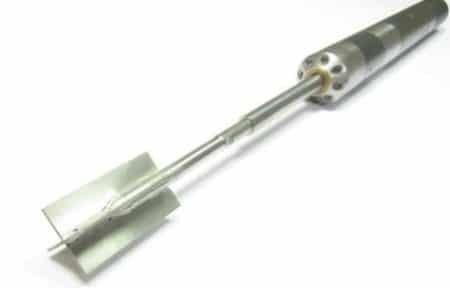Table of Contents
1. Introduction
Vane shear test on the soil is used to determine the shear strength ( particularly un-drained shear strength) of the soil. This soil test can be carried out both in the field and laboratory.
This test is an in-situ geotechnical investigation technique that is employed to determine the undrained shear strength of fully saturated clay without any disturbance.
Soil is an important constituent of any geotechnical investigation and construction thus it is necessary to determine the strength of the soil. This makes vane shear test an important type of test in geotechnical works.
The vane shear strength on soil was developed by L Carlson and AW Skempton in 1948.
The main advantage offered by this method is that it is relatively simple, quick and easy to perform.
It is highly desirable for determining the undrained shear strength of soft clay.
2. Objectives of Vane Shear Test
The main objectives of the vane shear test on soil can be listed as follows:
a. To determine the shear strength of soil i.e. the maximum shear strength of soil at which yielding or considerable plastic deformation occurs.
b. To determine the peak un-drained shear strength of soil i.e. the shear strength after significant failure and remoulding of the initial structure.
c. To assess the sensitivity of the soil sample i.e. measure of the effect of remoulding on the consistency of soil.

Figure: Mechanism of Vane Shear Test on Soil
3. Apparatus Required
a. Vane shear apparatus
b. Container for specimen
c. Vernier Callipers

Figure: Vane Shear Test Apparatus
4. The procedure of Vane Shear Test
a. Firstly, the vane shear apparatus is thoroughly cleaned. For the better movement of the handles, grease may be applied to the lead screw.
b. The container for the specimen which is generally about 75mm in height and 37.5mm in diameter is taken and the specimen is duly placed on it.
c. Then, using the screws, the soil at the top and the base of the vane shear test apparatus is thoroughly levelled.
d. The vane is then gradually lowered into the soil specimen until the top of the vane is immersed up to a depth of about 10 to 20mm into the specimen.
e. The initial reading is noted i.e. the reading of pointer on the circular graduated scale.
f. Then, the vane is rotated inside the soil specimen applying torque at the rate of 0.1 degree per second.
g. The final reading is noted when the specimen fails. When the specimen fails, the pointer in the graduated circle will move slightly backwards and the test must be stopped.
h. The angle of torque is determined as the difference between the final and initial reading.
i. The test procedure is repeated using two or three specimen sample so that the average value can be obtained.
j. The diameter and height of the vane are measured using vernier callipers.
k. The sensitivity of the soil sample can be determined by repeating the same test procedure on the remoulded soil. Remoulded soil is the soil specimen after the rapid stirring of the soil in the above-mentioned test.
The sensitivity of soil = undisturbed shear strength/remoulded shear strength
5. Observations & Calculations
The value of the shear strength of the soil is computed using the following relation:
Where,
S = Shear Strength of soil
D = Diameter of vane in cm
H = Height of vane in cm
T = Torque = (Spring constant / 180) * (initial reading – final reading)

6. Result
Shear strength of soil specimen = ________ kg/cm2.
7. Advantages of Vane Shear Test
a. This test is flexible i.e. it can be performed in the lab or field.
b. Vane shear test is relatively quick and easy.
c. Even the shear strength of soft clays at greater depth can be obtained by using this test.
8. Disadvantages of Vane Shear Test
a. This test cannot be conducted on the fissured specimen of clay.
b. Vane shear test is also not desirable for the clay specimen with a high sand or silt laminations.
c. Vane shear test does not give an accurate result if the failure envelope is not horizontal.
| Read Also: Triaxial Shear Test |


